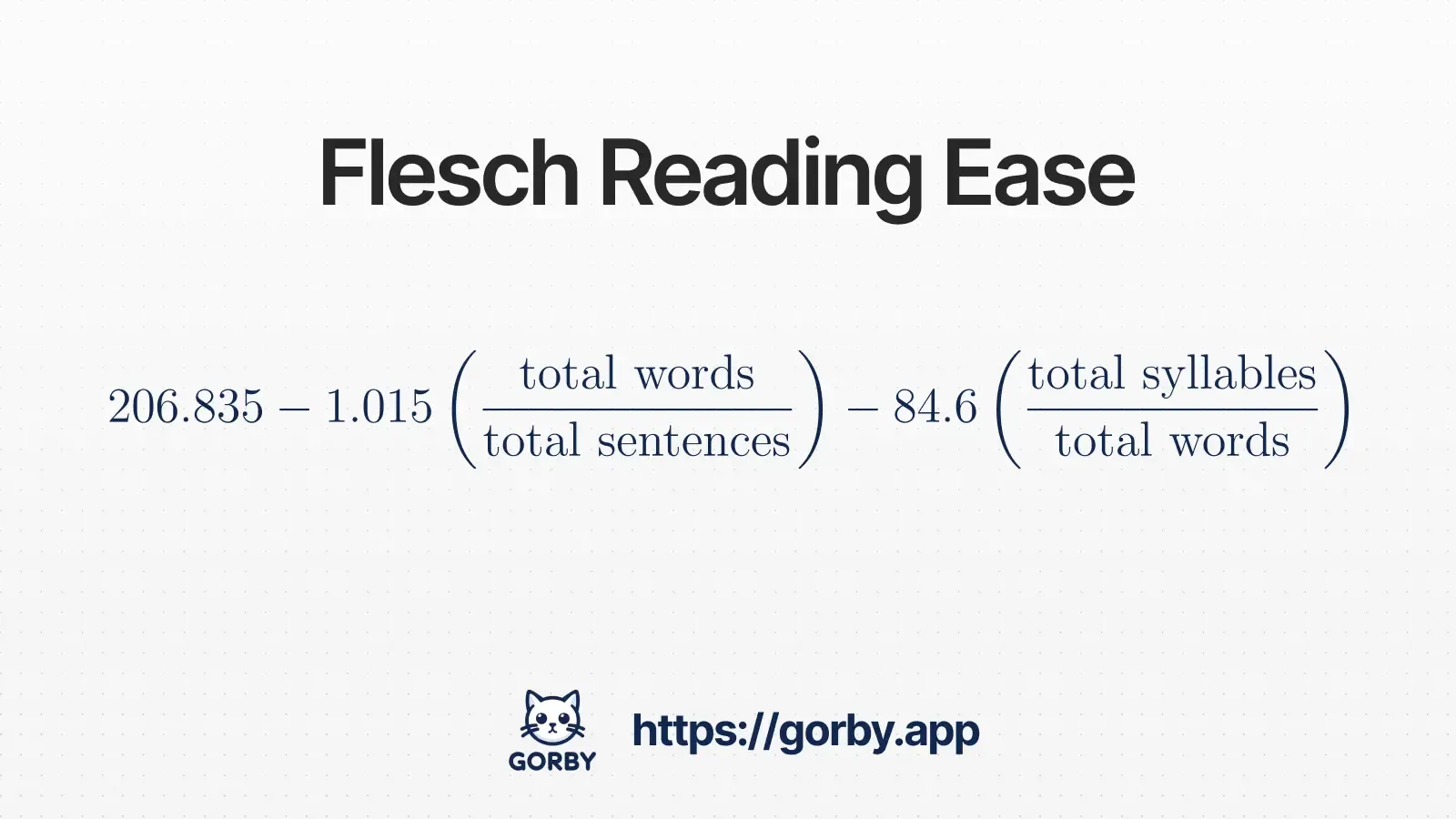Flesch Reading Ease Calculator and Formula
Calculate your text's readability instantly with the Flesch Reading Ease formula. Developed by Rudolf Flesch in 1948, this pioneering readability metric provides a score from 0 to 100, making it easy to assess and improve your content's accessibility. Perfect for writers, educators, and content creators looking to optimize their text's clarity and effectiveness.
Understanding the Flesch Reading Ease Score

What is the Flesch Reading Ease Score?
The Flesch Reading Ease score is one of the oldest and most accurate readability scoring systems available. Developed by Rudolf Flesch in 1948 and published in the Journal of Applied Psychology, this formula provides a score between 0 and 100, where higher scores indicate text that is easier to read and understand.
Unlike other readability metrics, the Flesch Reading Ease score is unique in that higher numbers mean better readability. A score of 100 represents text that is very easy to read, ideal for early readers, while a score near 0 indicates extremely complex text best suited for academic or professional content.
Historical Significance
When Flesch introduced this formula, it marked a significant advancement in the objective measurement of text readability. Originally developed as part of his doctoral research at Columbia University, the formula quickly gained widespread adoption due to its accuracy and ease of use. It became particularly influential in journalism, with many newspapers and magazines using it to ensure their content remained accessible to a broad audience.
How it Works
The formula analyzes two core components of your text:
- Sentence Length: The average number of words per sentence. Shorter sentences are generally easier to read and understand.
- Word Length: Measured by counting syllables per word. Words with fewer syllables are typically easier to read.
Real-World Applications
Today, the Flesch Reading Ease score is used across various fields:
- • Used by the U.S. Department of Defense for assessing document readability
- • Required by many U.S. states for insurance policies (e.g., Florida mandates a minimum score of 45)
- • Integrated into popular word processing software like Microsoft Word
- • Widely used in education to ensure textbooks match student reading levels
- • Applied in content marketing to optimize web content accessibility
The Flesch Reading Ease Formula Explained
Understanding the Components
The Flesch Reading Ease formula combines two key measurements with carefully calibrated weights to determine reading difficulty. Let's break down each component:
Average Sentence Length (ASL)
The first component (1.015 × ASL) measures syntactic complexity through average sentence length. The coefficient of 1.015 gives appropriate weight to this factor, with longer sentences decreasing the final readability score. This reflects the understanding that shorter sentences are generally easier to comprehend.
Average Syllables per Word (ASW)
The second component (84.6 × ASW) evaluates word complexity by measuring the average number of syllables per word. The larger coefficient of 84.6 indicates that word length has a stronger impact on readability than sentence length. Multisyllabic words tend to be more complex and decrease the readability score significantly.
Base Score (206.835)
The constant 206.835 serves as a baseline score that is adjusted downward based on sentence and word complexity. This number was carefully chosen to ensure the formula produces scores between 0 and 100 for most standard texts, with 100 representing maximum readability.
Calculation Guidelines
- Count sentences based on their natural ending points (periods, question marks, exclamation points, and sometimes semicolons)
- Count syllables as they are pronounced, not as they are written (e.g., "fire" has two syllables)
- Treat abbreviations and numbers according to how they would be read aloud
Interpreting Flesch Reading Ease Scores
| Score | Description | Education Level |
|---|---|---|
| 90-100 | Very Easy | 5th grade |
| 80-89 | Easy | 6th grade |
| 70-79 | Fairly Easy | 7th grade |
| 60-69 | Standard | 8th-9th grade |
| 50-59 | Fairly Difficult | 10th-12th grade |
| 30-49 | Difficult | College |
| 0-29 | Very Difficult | College Graduate |
Understanding Score Ranges
The Flesch Reading Ease score ranges from 0 to 100, with higher scores indicating easier readability. A unique feature of this scale is that you can achieve scores slightly above 100 in cases of extremely simple text using only one-syllable words in very short sentences.
General Content
For general audience content, aim for scores between 60-70. Major publications like Reader's Digest typically score around 65, making their content accessible to a broad audience.
Academic Writing
Academic texts often score between 30-50. The Harvard Law Review typically scores in the low 30s, reflecting its complex, specialized content.
Technical Documentation
For technical documents, scores between 50-60 are acceptable, balancing precision with clarity. Many government agencies require a minimum score of 45-50 for official documents.
Marketing Content
Marketing materials should aim for scores between 60-80, ensuring content is engaging and easily understood by the target audience.
📝 Pro Tip
Don't aim for the highest possible score in all cases. The optimal score depends on your audience and content type. Focus on matching your content's complexity to your readers' expectations and needs while maintaining the appropriate level of professionalism and technical accuracy.
Flesch Reading Ease vs Other Readability Metrics
While several readability formulas exist, the Flesch Reading Ease score remains one of the most widely used due to its unique advantages. Here's how it compares to other popular metrics:
Flesch Kincaid Grade Level
While based on the same core measurements, the Flesch-Kincaid Grade Level converts scores to U.S. grade levels instead of a 100-point scale. Both formulas use sentence length and syllable count but with different weighting factors, making them complementary rather than redundant tools.
Automated Readability Index
The ARI uses character count instead of syllable count, making it easier to compute automatically. While this can be more efficient, the Flesch Reading Ease score's syllable-based approach often provides a more nuanced assessment of word complexity.
Dale-Chall Readability Formula
The Dale-Chall formula relies on a list of "familiar" words rather than syllable count. While this can be more accurate for assessing vocabulary difficulty, the Flesch Reading Ease score is more universally applicable and doesn't require maintaining word lists.
Gunning Fog Index
The Gunning Fog Index focuses on complex words (those with three or more syllables) rather than average syllable count. The Flesch Reading Ease score provides a more granular analysis by considering all syllables, not just those in complex words.
Key Advantages of Flesch Reading Ease
- • Intuitive 0-100 scale where higher scores mean better readability
- • Widely supported in popular word processing software
- • Proven reliability through decades of research and use
- • No need for word lists or special dictionaries
- • Applicable across multiple languages and content types
Tips to Improve Your Flesch Reading Ease Score
Sentence Structure
- • Keep sentences under 20 words when possible
- • Break long sentences into shorter ones
- • Vary sentence length to maintain reader interest
- • Remove unnecessary words and phrases
- • Use active voice for clearer sentences
Word Choice
- • Choose shorter words over longer alternatives
- • Use one or two syllable words when possible
- • Replace complex words with simpler synonyms
- • Avoid unnecessary technical jargon
- • Use familiar, everyday language
Content Organization
- • Use clear paragraph breaks
- • Include helpful subheadings
- • Present information in logical order
- • Use bullet points for complex lists
- • Keep paragraphs focused on single topics
Editing Process
- • Check your score while writing
- • Read content aloud to identify issues
- • Review for unnecessary complexity
- • Get feedback from target audience
- • Make iterative improvements
Common Word Replacements
| Complex Word | Simpler Alternative |
|---|---|
| utilize | use |
| demonstrate | show |
| approximately | about |
| sufficient | enough |
| determine | find |
Remember: The goal isn't always to achieve the highest possible Flesch Reading Ease score. Instead, aim for a score that matches your target audience's reading level while maintaining the appropriate level of professionalism and technical accuracy. For general audience content, a score between 60-70 is often ideal.
Ready to Analyze Your Text?
Try our comprehensive suite of readability tools and improve your writing today.
Get instant readability insights with our complete text analysis toolkit. Check word counts, readability metrics, and get writing suggestions all in one place.
Resources and References
Original Research Paper (1948)
Flesch, R. "A New Readability Yardstick" - This foundational paper introduced the Flesch Reading Ease formula and established its 0-100 scale. The paper details the research methodology, validation studies, and practical applications of the formula.
Read the paperU.S. Navy Research (1975)
Kincaid, J.P., et al. "Derivation of new readability formulas" - This comprehensive report documents the validation and modification of Flesch's original formula, including extensive testing with Navy personnel and the development of grade-level conversions.
View the reportFlesch Reading Ease on Wikipedia
A comprehensive overview of the Flesch Reading Ease score, including its history, applications, and comparisons with other readability metrics. Features detailed examples and interpretations of the scoring system.
Read more
More Readability Tools
All Readability Metrics
Overview of all readability formulas and tools
Automated Readability Index (ARI)
Calculate grade level based on character count
Coleman-Liau Index
Analyze text complexity using characters per word
Dale-Chall Readability
Evaluate readability using word familiarity
Flesch-Kincaid Grade Level
Convert text complexity to U.S. grade levels
Gunning Fog Index
Measure text complexity using sentence length and word difficulty
SMOG Index
Assess readability based on polysyllabic words
Spache Readability Formula
Evaluate early reading materials using familiar word lists
